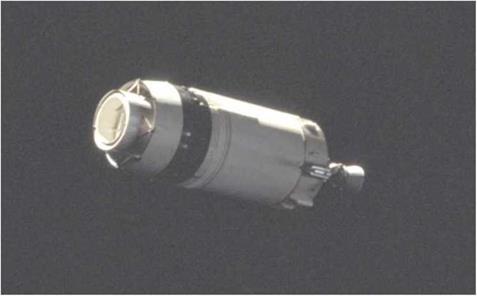THE FATE OF THE S-IVB
In some romantic sense, the S-IVB stage had the most bittersweet, almost tragic fate of all the Saturn components. These large, perhaps elegant stages had been faithful servants to their Apollo masters, who they dutifully sent onwards to the Moon. They were spared the ignominious crash into the sea that befell their larger brethren, the SIC and the S-II. Instead, they were sent away from Earth to meet a celestial end. Of the ten manned Saturn V third stages – nine of which were Moon bound – half were sent to impact the Moon at high speed in the name of science and lunar seismometry, while the others coasted away from the Earth-Moon system to follow lonely orbits around the Sun, perhaps for all time.
|
Apollo 8’s S-IVB soon after the departure of the CSM. Instead of a LM, a 9-tonne cylindrical tank of water known as LTA-B had been installed as ballast to maintain the vehicle’s centre of mass. (NASA) |
After the departure of their Apollo payload, they became spacecraft in their own right, controlled from Karih or by the systems in the Saturn’s instrument unit until either their batteries ran out or the ground stations ceased to track the receding hulks. The people who controlled the S-IVB from Earth used what little residual propulsion the stage had remaining to achieve these final ends.
After translunar injection, both the S-IVB and the spacecraft were on very similar trajectories which were initially highly elliptical Earth orbits; but the intervening gravitational influence of the Moon would determine the final fate of both craft. While the Apollo spacecraft continued on a path to lunar orbit, the S-IVB was given one of two fates.
For the early lunar Apollo missions, a decision was made to ensure that the S-IVB would be taken well clear of the spacecraft and, in effect, dumped in solar orbit. To achieve this, its remaining propulsion was used to slow it down, so that while the spacecraft would pass the Moon’s leading hemisphere, the stage would be targeted to pass the Moon’s trailing hemisphere and receive a gravitational slingshot that would eject it from the Earth-Moon system. This was the fate of four of the Apollo S-IVB stages and they arc out there, drifting still. Although the Apollo 9 mission never went to the Moon, its S-IVB was nevertheless sent out of Earth orbit as a rehearsal and it, too. orbits the Sun. Like the others, it is slightly inside Earth’s orbit and periodically catches up with Earth.
As Apollo 17 headed out from the Moon, the crew saw something in the distance flashing at them regularly. Jack Schmitt had seen it earlier and Cernan had caught a glimpse of it. "Hey, Bob, I’m looking at what Jack was talking about,” said Cernan to Robert Parker, their Capcom. "It is a bright object, and it’s obviously rotating because it’s flashing. It’s way out in the distance. It’s apparently rotating in a very rhythmic fashion because the flashes come around almost on time.”
They discussed the idea of turning the spacecraft around to enable them to look at the object with their optics, which were mounted on the opposite side. What could be seen out of the windows could not be viewed through the optics any more than windows at the front of a house could be used to look around the back. Anyway, Schmitt was in the habit of using a 10-power monocular to view – Earth’s weather patterns and when he trained it on the object, he reckoned it to be their S-IVB, some way off.
"One unique thing about it. Bob. is that it’s got two flashes,” said Cernan. "As it comes around in rhythmic fashion, you get a very bright flash, and then you get a dull Hash. And then it’ll come around with a bright Hash, and then a dull flash.”
‘"That’s the side of the S-IVB.” said Schmitt, “and then the engine bell. Gene.”
Cernan didn’t believe him. "The commander doesn’t think that I can see the engine bell on that thing,” commented Schmitt.
‘"Roger, Jack. Is that w’ith the monocular you’re looking at it?” asked Parker.
“He couldn’t see the engine bell if he had ten monoculars.” said Cernan wryly.
‘’Bob, a couple of revolutions ago when I was looking at it, I had a much brighter view and I believe I was looking at it broadside.” said Schmitt. "It looks to me like it may be flashing more or less end-on now. But it’s not as bright now as it was a while ago. I just hadn’t put it together as maybe being the S-IVB. I thought it was just some other particle out there.”
”IIey. Bob,” said Cernan later. ‘’We got two of those flashers out there. They could be SLA panels. I don’t know. They’re alike in intensity and pretty regular in the bright and dim flashes they come out with, and they’re widely separated.”
We’ll never know whether Cernan and Schmitt were seeing the S-IVB stage or a couple of SLA panels. We do know that other crew saw flashes from discarded equipment. But as events transpired it was not the last meeting the human race would have with an Apollo cast-off.











